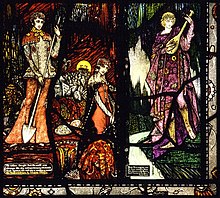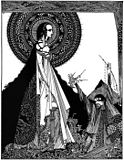Harry Clarke
Harry Clarke | |
|---|---|
 | |
| Born | Henry Patrick Clarke 17 March 1889 |
| Died | 6 January 1931(aged 41) |
| Resting place | Chur (disinterred in 1946 and reburied in an unknowncommunal grave) |
| Alma mater | Dublin Metropolitan School of Art |
| Known for | stained glassandbook illustration |
| Movement | Arts and Crafts |
| Spouse | Margaret Clarke |
Henry Patrick ClarkeRHA(17 March 1889 – 6 January 1931) was an Irishstained-glassartist andbook illustrator.Born inDublin,he was a leading figure in the IrishArts and Crafts Movement.
His work was influenced by both theArt NouveauandArt Decomovements. His stained glass was particularly informed by the FrenchSymbolistmovement.
Early life
[edit]Henry Patrick Clarke was born on 17 March 1889, the younger son and third child of Joshua Clarke and Brigid (née MacGonigal) Clarke.[1]Joshua Clarke was a church decorator who moved to Dublin fromLeedsin 1877 and started a decorating business,Joshua Clarke & Sons,which later incorporated a stained glass division. Through his work with his father, Clarke was exposed to many schools of art but Art Nouveau in particular.[citation needed]
Clarke was educated at the Model School in Marlborough Street, Dublin andBelvedere College,which he left in 1905. He was devastated by the death of his mother in 1903 when he was only 14 years old.[2][3]Clarke was then apprenticed into his father's studio, and attended evening classes in theMetropolitan College of Art and Design.HisThe Consecration ofSt Mel,BishopofLongford,bySt Patrickwon the gold medal for stained glass work in the 1910 Board of Education National Competition.[1]He won the Gold Medal for stained glass at the 1911, 1912, and 1913 South Kensington National Competitions. He also exhibited at the 1912 International Art Congress in Dresden, Germany, and the 1914Exposition des Arts Décoratifs de G. Bretagne et d'Irlandeat theLouvrein Paris.[4]
At the art school in Dublin, Clarke met fellow artist and teacher,Margaret Crilley.[1]They married on 31 October 1914 and moved into a flat at 33North Frederick Street.In subsequent years the Clarkes lived in various locations in Dublin, including a semi-detached house in Cabra in which Margaret Clarke painted her husband at work. The Clarkes had three children, Michael, David, and Ann.[1]
Career
[edit]
Book illustration
[edit]Clarke briefly moved to London to seek work as a book illustrator. Picked up by London publisherHarrap,[3]he started with two commissions which were never completed:Samuel Taylor Coleridge'sThe Rime of the Ancient Mariner(much of his work on which was destroyed during the 1916Easter Rising) and an illustrated edition ofAlexander Pope'sThe Rape of the Lock.[5]
Clarke was commissioned by the Committee of the Irish National War Memorial[6]in 1919 to illustrate theIreland's Memorial Records 1914-1918,a roll of honour for the 49,435 Irish who died duringWorld War I.Illustrations for the 8 volumes were completed in 1922 and published in 1923, and a set is on display in the Irish National War Memorial Gardens. 100 copies of the book were distributed to cathedrals and libraries across Ireland and to other Allied countries. Each page features a large four-sided border of black and white illustrations by Clarke.[7]
Difficulties with these projects madeFairy Tales byHans Christian Andersenhis first printed work, in 1916. It included 16 colour plates and more than 24 halftone illustrations. This was followed by illustrations for an edition ofEdgar Allan Poe'sTales of Mystery and Imagination:the first version of that title was restricted tohalftoneillustrations, while a second with eight colour plates and more than 24 halftone images was published in 1923.[5]
This 1923 edition made his reputation as a book illustrator, during the golden age of gift-book illustration in the first quarter of the twentieth century. It was followed by editions ofThe Years at the Spring,with 12 colour plates and more than 14 monotone images; (Lettice D'Oyly Walters,ed., 1920),Charles Perrault'sFairy Tales of Perrault,andGoethe's Faust,with eight colour plates and more than 70 halftone and duotone images (New York: Hartsdale House, 1925). The last of these is his most famous work, prefiguring the imagery of 1960spsychedelia.[5]Two of his most sought-after titles are promotional booklets forJameson Irish Whiskey:A History of a Great House(1924, and subsequent reprints) andElixir of Life(1925), which was written by Geofrey Warren. His final book,Selected Poems ofAlgernon Charles Swinburne,was published in 1928.[1]
Stained glass
[edit]
Clarke produced more than 130 windows, he and his brother Walter had taken over his father's studio after his death in 1921.[1]His glass is distinguished by the finesse of its drawing and his use of rich colours, and an innovative integration of the window leading as part of the overall design, originally inspired by an early visit to see the stained glass of theCathedral of Chartres.He was especially fond of deep blues. Clarke's use of heavy lines in his black-and-white book illustrations echoes his glass techniques.[5]
Clarke's stained glass work includes many religious windows, but also much secular stained glass. Highlights of the former include the windows of theHonan ChapelinUniversity College Cork;of the latter, a window illustratingJohn Keats'The Eve of St. Agnes(now in theHugh Lane Municipal Galleryin Dublin) and theGeneva Window,created for theCentre William Rappardin Geneva, Switzerland (now in theWolfsonian Museum,Miami, Florida, US).[5]Perhaps his most seen works were the windows he made forBewley's Caféon Dublin'sGrafton Street,[1]which was subject to court proceedings in 2022 in a dispute between landlord and tenant over ownership, asRGRE v Bewley's.[8]
Later years and death
[edit]
Both Harry and his brother Walter were plagued with ill health, in particular problems with their lungs.[5]Clarke was diagnosed withtuberculosisin 1929, and went to a sanatorium inDavos,Switzerland.[1]Fearing that he would die abroad, he began his journey back to Dublin in 1931, but died on 6 January 1931 inChurwhere he was buried. A headstone was erected; but local law required that the family pledge to maintain the grave 15 years after the death. This was not explained to the Clarke family and Harry Clarke's remains were disinterred in 1946 and reburied in a communal grave.[1][9]
Legacy
[edit]In 2019 a bridge inCabra, Dublin,was renamed "Harry Clarke Bridge" in his honour.[10]
Gallery
[edit]Stained glass windows
[edit]-
Saint Gobnait,Honan Chapel,Cork, 1916
-
St Anne and Mary,St Mel's Cathedral,Longford
-
Chapel of the Sacred Heart, Dingle,The Baptism of Jesus,1922–24
-
"Vision of Bernadette at Lourdes", Church of Saint John the Baptist, Duhill,County Tipperary
Illustrations
[edit]-
Queens whose finger once did stir men( "The Playboy of the Western World"), 1917
-
Illustration forEdgar Allan Poe's "Ligeia",1923
-
The Fairy,from Fairy tales ofCharles Perrault,1922
-
The Colloquy of Monos and Una,Edgar Allan Poe series, 1923
-
Faust, page 2, 1925
-
FromElixir of Life,G. C. Warren, 1925
Works
[edit]As illustrator
[edit]- Andersen, H. C.—The Fairy Tales of Hans Christian Andersen,George Harrap, London, 1916
- Poe, E. A.—Tales of Mystery and Imagination,George Harrap, London, 1919
- Walters, L. d'O.—The Year's at the Spring,George Harrap, London, 1920The Year's at the Springvia HathiTrust
- Perrault, C.—The Fairy Tales of Charles Perrault,George Harrap, London, 1922
- _____Ireland's Memorial Records 1914–1918,Maunsel and Roberts, Dublin, 1923Volume Five via Trinity College Dublin
- Warren, G. C. —The History of a Great House,John Jameson & Son, Dublin, 1924
- Warren, G. C. —Elixir of Life {Uisge Beatha}John Jameson & Son, Dublin, 1925
- Goethe, J. W. von—Faust,George Harrap, London, 1925
- Swinburne, A. C.—Selected Poems of Charles Swinburne, JohnLane, London, 1928
See also
[edit]- An Túr Gloine,stained glass firm with which Clarke was associated
- Harry Clarke - Darkness In Light
References
[edit]- ^abcdefghiAndrews, Helen; White, Lawrence William (2009). "Clarke, Harry (Henry Patrick)". In McGuire, James; Quinn, James (eds.).Dictionary of Irish Biography.Cambridge: Cambridge University Press.
- ^The Irish genius behind the world's most iconic stained glass windows,Irish Central, 5 June 2016.
- ^ab"About Harry Clarke (1889-1931)".The Hugh Lane Gallery.Retrieved10 May2015.
- ^Bowe, Nicola Gordon (1985)."The Arts and Crafts Society of Ireland (1894-1925) with particular reference to Harry Clarke".The Journal of the Decorative Arts Society 1850 - the Present(9): 29–40.ISSN0260-9568.JSTOR41809143.
- ^abcdefCostigan, Lucy; Cullen, Michael (2010).Strangest Genius: The Stained Glass of Harry Clarke.Dublin: The History Press Ireland.ISBN9781845889715.
- ^"Ireland's memorial records 1914-1918: being the names of Irishmen who fell in the Great European War, 1914-1918. Volume five. Ker to M'Gil".Digital Collections: The Library of Trinity College Dublin.Retrieved2 February2022.
- ^Helmers, Marguerite (12 December 2015)."Harry Clarke's first World War".The Irish Times.Retrieved2 February2022.
- ^"Judgment on Bewley's Harry Clarke windows is delayed".Business Post.
- ^ Nicola Gordon Bowe. 1994.The Life and Work of Harry Clarke(Irish Academic Press)
- ^Burns, Sarah (27 April 2019)."Dublin bridge renamed after stained-glass artist Harry Clarke".The Irish Times.
Further reading
[edit]- Nicola Gordon Bowe. 1994.The Life and Work of Harry Clarke(Irish Academic Press)
- Martin Moore Steenson. 2003.A Bibliographical Checklist of the Work of Harry Clarke(Books & Things)
- John J Doherty. 2003.Harry Clarke - Darkness In LightA film on the life and work of Harry Clarke (Camel Productions)
- Lucy Costigan and Michael Cullen. 2010.Strangest Genius: The Stained Glass of Harry Clarke(The History Press Ireland)
- Teehan, Virginia;Heckett, Elizabeth.The Honan Chapel: A Golden Vision.Cork: Cork University Press, 2005.ISBN978-1-8591-8346-5
- Marguerite Helmers,Harry Clarke’s War: Illustrations for Ireland’s Memorial Records, 1914-1918(Irish Academic Press, 2015).ISBN9780716533078
- Angela Griffith, Marguerite Helmers & Róisín Kennedy (Eds),Harry Clarke and Artistic Visions of the New Irish State(Irish Academic Press, 2018).ISBN9781788550451
- Lucy Costigan and Michael Cullen,Dark Beauty: Hidden Detail in Harry Clarke’s Stained Glass(Merrion Press 2019).ISBN9781785372339
External links
[edit]- Harry Clarke Stained Glass Site
- Harry Clarke's family tree
- Works by Harry ClarkeatProject Gutenberg
- Harry ClarkeatLibrary of Congress,with 10 library catalogue records
- Harry Clarke's Looking Glassat The Public Domain Review
- Stained Glass Studio Archiveat Trinity College Dublin
- Harry Clarke
- Irish illustrators
- Irish stained glass artists and manufacturers
- 1889 births
- 1931 deaths
- Arts and Crafts movement artists
- Fantasy artists
- Irish speculative fiction artists
- Swiss speculative fiction artists
- Alumni of the National College of Art and Design
- People associated with University College Cork
- People educated at Belvedere College
- Tuberculosis deaths in Switzerland
- 20th-century deaths from tuberculosis
- Illustrators of fairy tales
- Mac Conghail family
- Artists from Dublin (city)
- 20th-century illustrators










